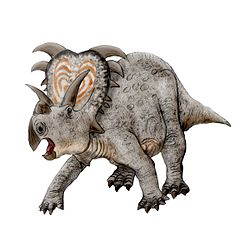- Medusaceratops
-
Medusaceratops
Temporal range: Middle Campanian, 77.5 Ma
Artist's restoration of Medusaceratops Scientific classification 
Phylum: Chordata Class: Reptilia Superorder: Dinosauria Order: †Ornithischia Suborder: †Ceratopsia Family: †Ceratopsidae Subfamily: †Chasmosaurinae Genus: †Medusaceratops
Ryan, Russell & Hartman, 2010Species: †M. lokii Binomial name Medusaceratops lokii
Ryan, Russell & Hartman, 2010Medusaceratops (meaning "Medusa horn face") is a genus of herbivorous ceratopsian dinosaur. It is a chasmosaurine ceratopsian which lived during the Late Cretaceous period (middle Campanian stage) in what is now Montana. It is known from two partial parietals, the holotype WDC DJR 001 and the paratype WDC DJR 002. All specimens of Medusaceratops were collected from the Judith River Formation, dating to 77.5 million years ago. It is the oldest known chasmosaurine ceratopsid.
The name "Medusaceratops" was coined by Canadian paleontologist Michael J. Ryan of the Cleveland Museum of Natural History in 2003 in a dissertation. These fossils were confused with those of Albertaceratops, an unrelated centrosaurine ceratopsian from Alberta which had been described in 2007. Later, Ryan realized that at least some of the "Medusaceratops" fossils did not belong to Albertaceratops. Medusaceratops was formally described by Michael J. Ryan, Anthony P. Russell and Scott Hartman in 2010 and the type species is Medusaceratops lokii.[1]
References
- ^ Ryan, Michael J.; Russell, Anthony P., and Hartman, Scott. (2010). "A New Chasmosaurine Ceratopsid from the Judith River Formation, Montana", In: Michael J. Ryan, Brenda J. Chinnery-Allgeier, and David A. Eberth (eds), New Perspectives on Horned Dinosaurs: The Royal Tyrrell Museum Ceratopsian Symposium, Indiana University Press, 656 pp. ISBN 0253353580.
This article related to ceratopsian dinosaurs is a stub. You can help Wikipedia by expanding it.
